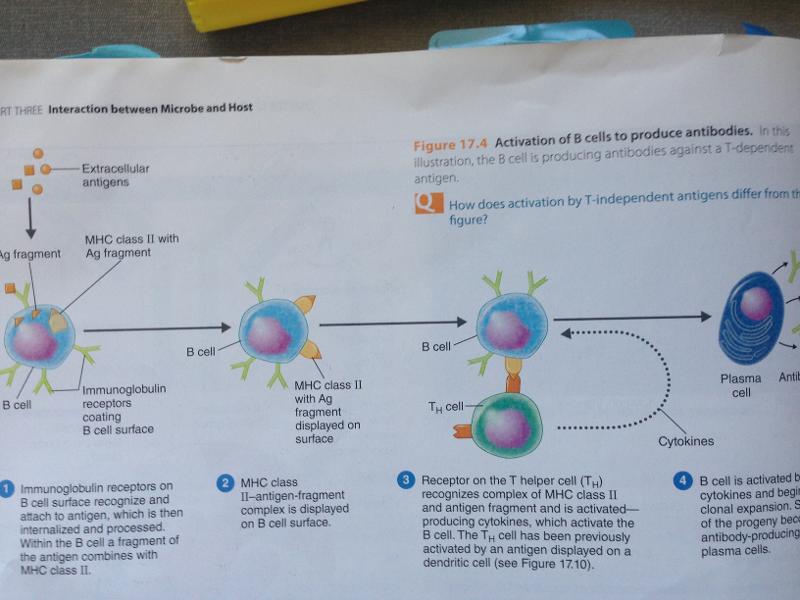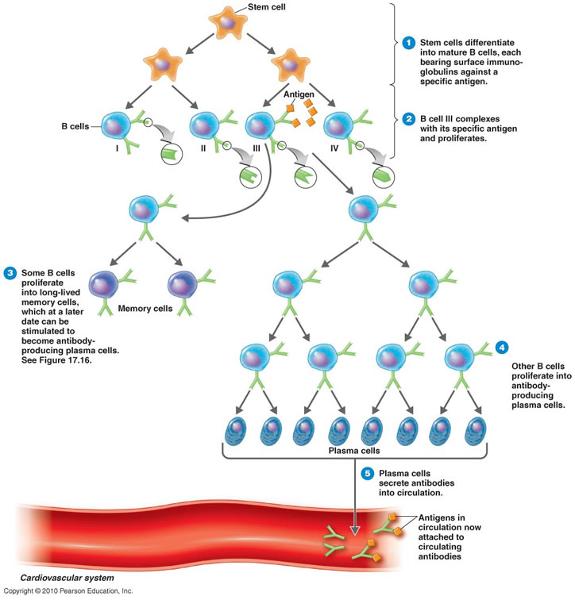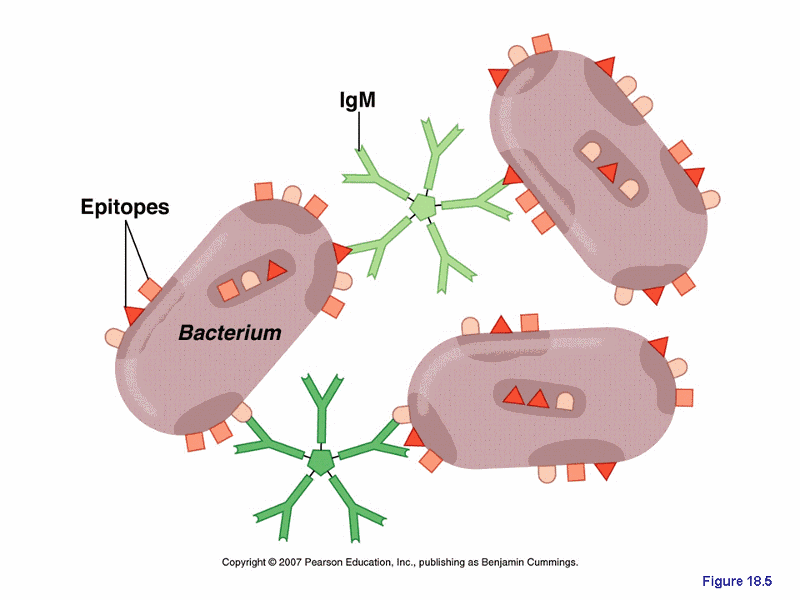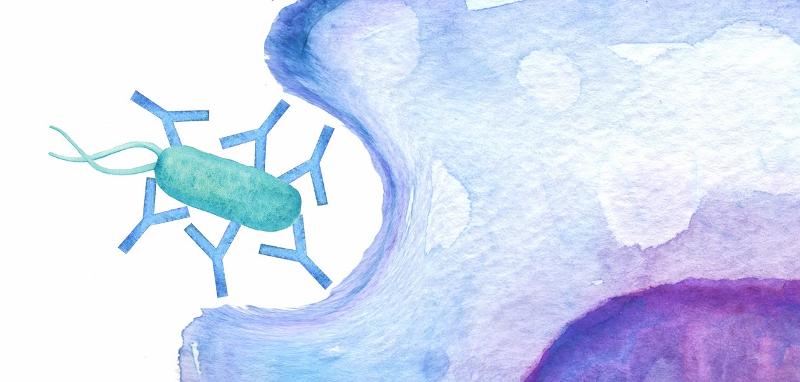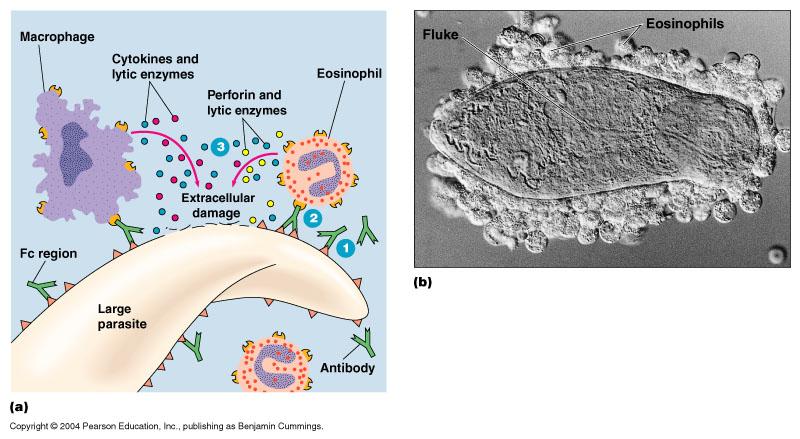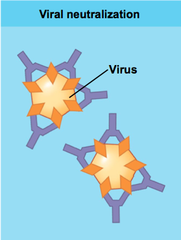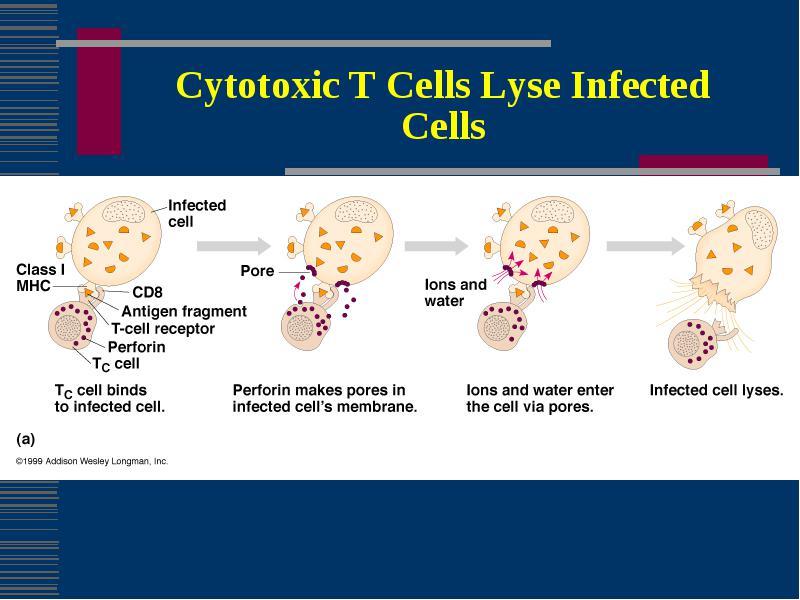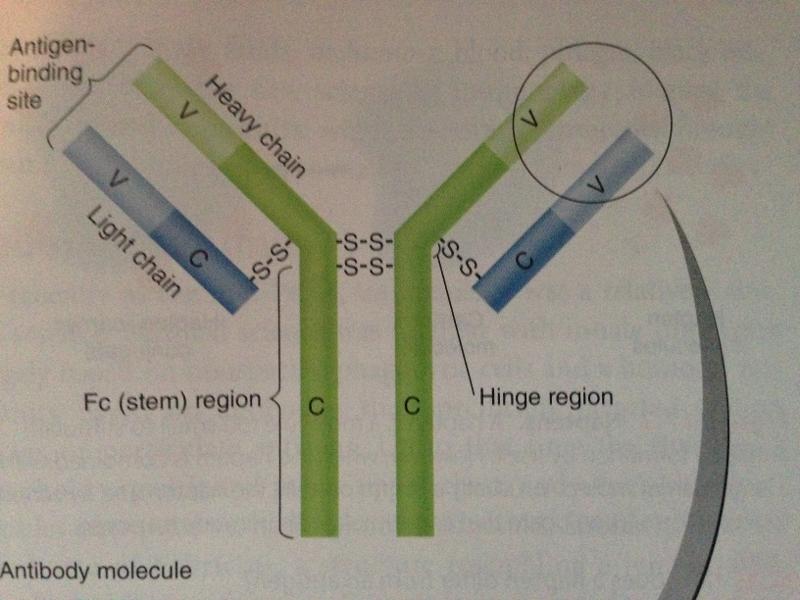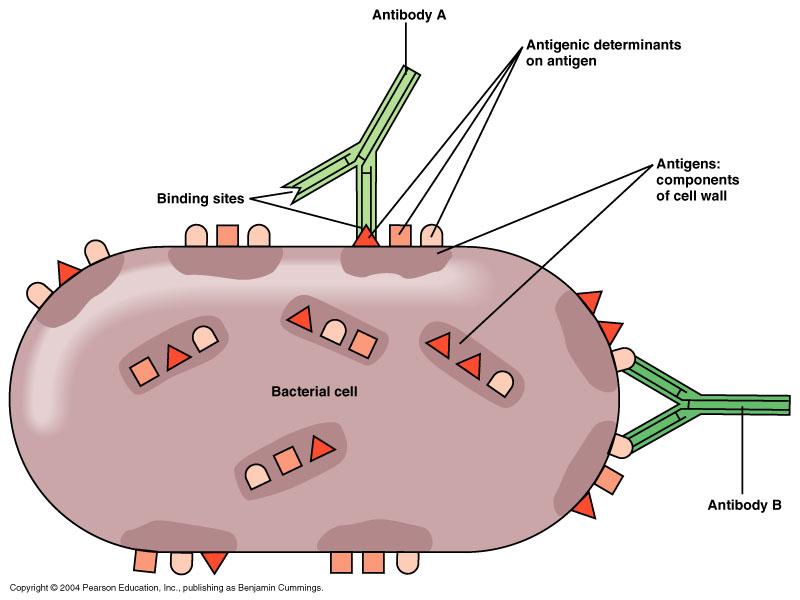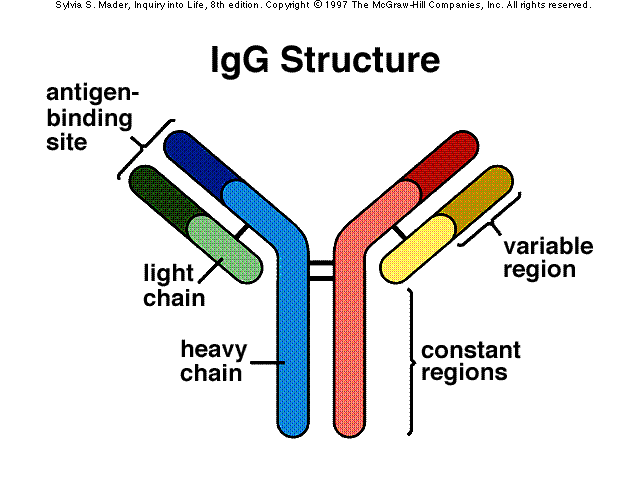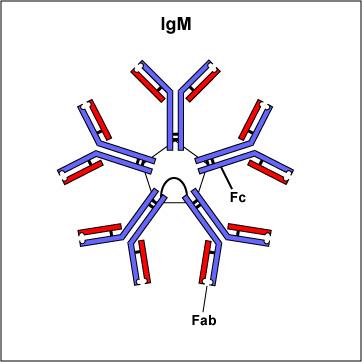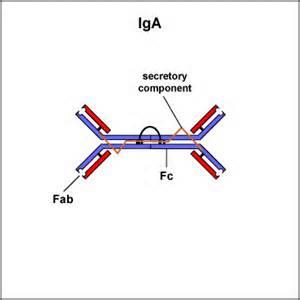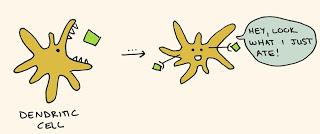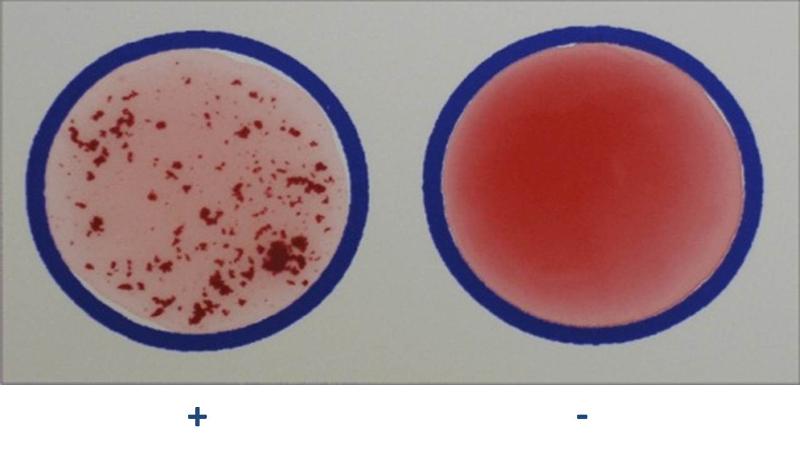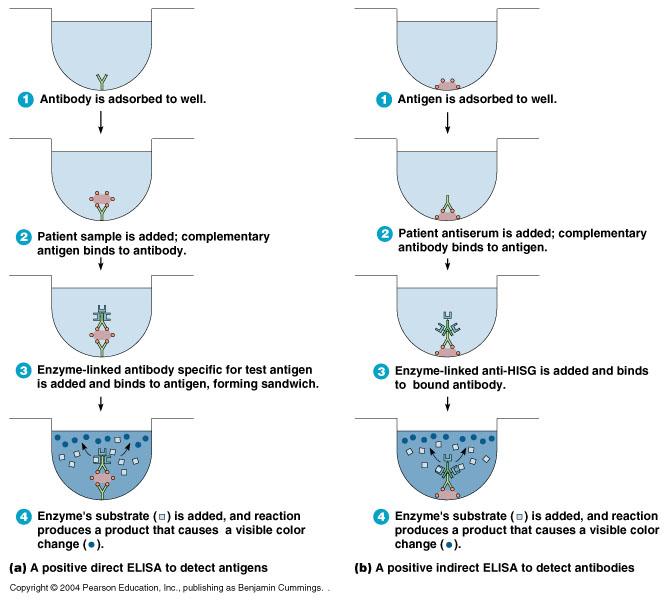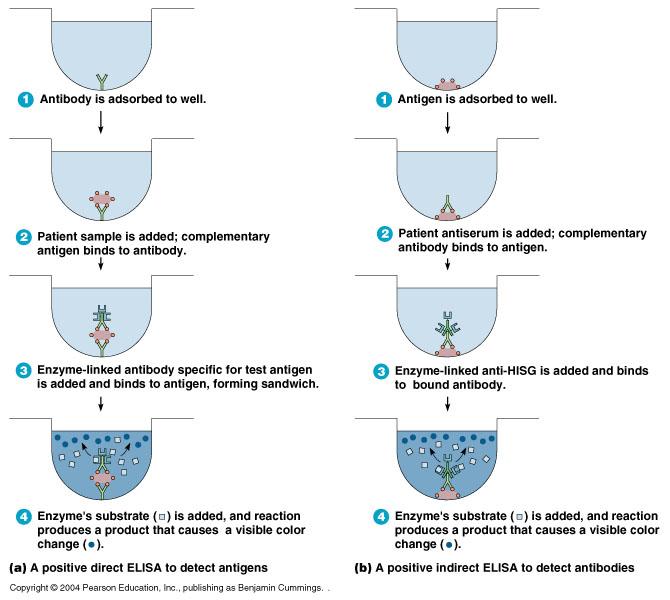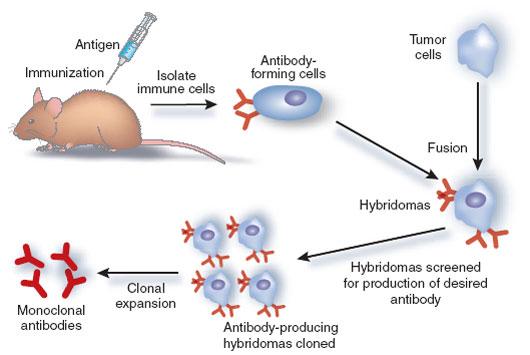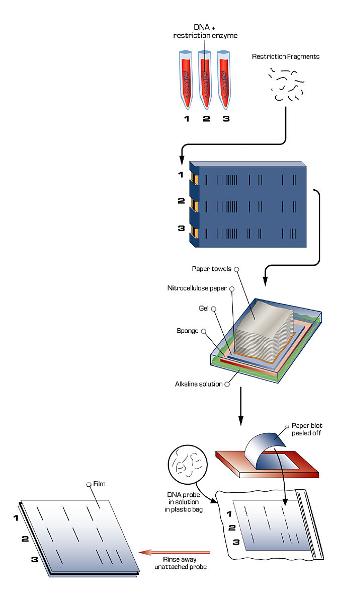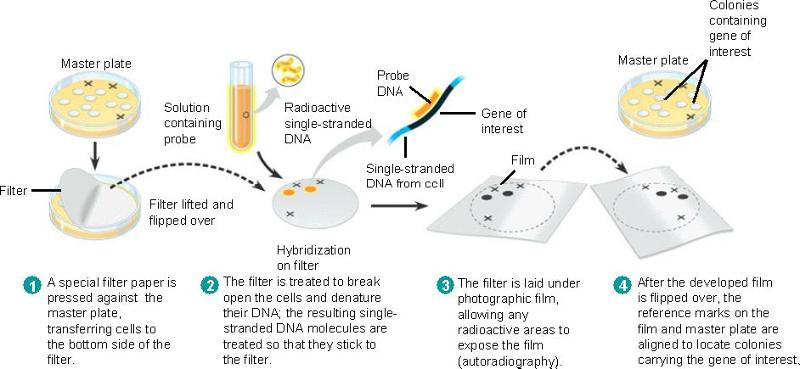| back 1 - globulin proteins
- term immunoglobulins(ig)
used for antibodies
- made in response to an
antigen, in which they can recognize and bind to
-
antigen-binding sites at least two identical sites
that binds to epitopes
- basis of humoral immune
response
|
| back 2 - Type of lymphocyte that develops & matures in bone
marrow.
- circulate in blood and lymph system
- activated when their receptors recognize and respond to antigens
by making specific antibodies
- can become memory cells
|
front 3 How are B cells activated?What happens when they are activated? | back 3 - Process begins when B cells are exposed to free, or
extracellular antigens
- activated when a B-cell's
immnuoglobulins (located on its surface) binds to the epitope for
which they become specific
- when activated B-cells under go
proliferation
- Usually needs assistance from T Helper
cells
|
front 4 Define: Major histocompatibility complex (MHC) | back 4 - A collection of genes that is made up of glycoproteins that are
found on the plasma membrane on cells that help the immune system
recognize self from nonself; preventing the immune system from
making antibodies that would be harmful to the host.
|
| back 5 - only found on antigen-presenting cells (ie. macrophages,
b-cells, dendrites)
- When an antigen activates a B-cells,
fragments of the antigen and the MHC class to are presented on the
surface of the cell for the receptors of the T helper cells to
identify.
|
| back 6 - an activated B cell proliferates into a large clone of cells
some of which differentiate in to antibody producing plasma
cells
-
a mature B lymphocyte that is specialized for antibody
(immunoglobulin) production
|
| back 7 - clones of activate B cells (that do not become plasma cells)
and Helper T cells that exist as long-lived but non proliferating
memory cells responsible for the more rapid secondary response when
the antigen is encountered on a subsequent occasion.
- vaccinations are used to initiate the production of memory
cells.
|
| back 8 - the development of clones of B and T cells against a specific
antigen
|
| back 9 - binding of an antibody to an antigen protects the host by
tagging foreign cells and molecules for destruction by phagocytes
and complement.
- antibody binds to antigens epitope
|
| back 10 - one of the possible outcomes of antigen-antibody binding
- antibodies cause antigens to clump together
- the two
antigen binding sites on an Ig combine with epitopes on two
different foreign cells, making them clump with makes them easily
ingested by phagocytes
- reduces the number of infection
units to be dealt with
|
| back 11 - one of the possible outcomes of antigen-antibody binding
- the antigen is coated with antibodies that enhance the ingestion
and lysis by phagocytic cells
|
front 12
antibody-dependent cell-mediated cytotoxicity | back 12 - one of the possible outcomes of antigen-antibody binding
- the pathogen is first coated with antibodies then a variety of
cells of the immune system bind to the Fc regions of the
on the antibodies & thus the pathogen, the attacking cells them
secrete substances such as perforin and lytic enzymes that cause the
pathogen to be lysed
|
| back 13 - possible out come of antigen-antibody binding
- IgG
antibodies inactivate microbes by blocking their attachment to host
cells; neutralize toxins in a similar way
|
front 14
activation of the complement system | back 14 - one of the possible outcomes of and antigen-antibody
binding
- the attachment of microbes of an antibody-complement
complex
- causes inflammation and cell lysis
- attracts
phagocytes and other defensive immune system cells to the area
|
| back 15 - lymphocytes develop from stem cells in bone marrow; reach
maturity in the thymus where they go through a process called thymic
selection in which the T cells that will not specifically recognize
self-molecules of MHC are weeded out---> important in preventing
the body from attacking its own tissues
- respond to the need
to combat intracellular pathogens
- also the way in which the
immune system recognizes cells that are nonself
- to
recognize an antigen they require antigen fragments be presented by
antigen presenting cells.
- do not have immunoglobulins on
surface but rather TCRs ( T cell receptor)
|
front 16 T Helper Cells (CD4+ T Cells) | back 16 - TH1 cells activate cells involved with cellular
immunity: macrophages, Tc cells, Natural killer
cells
- TH2 cells are associated with allergic
reactions and parasitic infections; stimulate eosinphils, IgM, &
IgE
- Th17 cells activate innate immunity and
responses to extracellular bacteria; situated in the skin and in the
lining of the gastrointestinal tract
-
T helper cells, or CD4+ T cells, are activated by
MHC class II on APCs. After binding on an APC, CD4+ T
cells secrete cytokines that activate other T cells and B
cells
|
front 17
T regulatory cells (Treg) | back 17 - main function is to combat autoimmunity by suppressing T cells
that might act on the body's self
|
front 18
T Cytotoxic Cells (CD8+ T cells) | back 18 - T cytotoxic cells are activated by endogenous antigens and MHC
class I on a target cells and are transformed into CTLs (Cytotoxic T
Lymphocyte)
- CTLs attache to the target cells and releases
perforin then granzymes resulting in Apoptosis (programmed cell
death)
- Primarlily the target cells are self cells that have
been altered by infection with a pathogen especially viruses
|
| back 19 - a substance that causes the body to produce antibodies
- include toxins, bacteria, foreign blood cells, and the cells of
transplanted organs
- either proteins or large
polysaccharides (nucleic acids and lipids only pathogenic when
combined with proteins and polysaccharides
|
front 20 monomer antibody structure | back 20 - two antigen-binding sites that form a Y's arms called
variable (V) regions
- the stem of the antibody
monomer is called the constant (C) regions; the same for a
particular class of immunoglobulin; there are 5 major C class
- The stem of the of the "Y" shaped antibody is called
the Fc region
- If left exposed after both
antigen-binding sites attach to antigen, the Fc regions of adjacent
adjacent antibodies can bind complement---> destruction of
antigen; Fc region may also bind to a cell leaving antigen binding
sites free to react with antigens
|
front 21 Define: epitope or antigenic determinant | back 21 - specific regions on an antigen that antibodies recognize,
respond and can bind to
- nature of this interaction depends
on the size, shape, and chemical structures of the binding site on
the antibody molecule
- antigens carries more than one
epitope
|
| back 22 - structure: monomer
- 80% of all antibodies in serum
- in regions of inflammation; readily crossed blood vessels into
tissue
-
Location: blood, lymph and intestine
-
Known functions: when bound to pathogens enhances
phagocytosis, neutralizes toxins and viruses, trigger the
complement system, protect against circulating bacteria and
viruses
|
| back 23 - stucture: pentamer (remember M for macro= their large
size)
- up to 5-10% of antibodies
-
located in blood, lymph, B cell surface(as
monomer); large size prevents IgMs from moving about
freely
-
known functions: especially effective against micro
organisms and agglutinating antigens; predominant antibody
involved in the response to the ABO blood group antigens on the
surface of RBCs; first antibodies produces in response to initial
infection
- short lived (5days) which makes it useful
in diagnosing if there are high concentrations of IgM against a
pathogen, its likely that the disease observed is caused by that
pathogen
|
| back 24 - structure: dimer( with secretory component)
- up to
10-15% in serum, but most common antibodies in mucous membranes and
in body secretions with this is consideration, it is the most
abundant Ig in the body
-
locations: secretions(tears, saliva, mucus, intestine, milk)
blood, lymph
-
Functions: prevent attachment of microbial pathogens to
mucosal surfaces
|
| back 25 - structure monmer
- make up only about 0.2% of antibodies
in serum
- location: B cell surface, blood,
lymph
-
Functions: not know; presence on B cell functions in
initiation of immune response
|
| back 26 - 0.002% of antibodies in serum
-
location: bound to mast and basophil cells throughout body;
blood
-
Functions: aides in allergic reactions- when antigen like
pollen touches the IgE antibodies that are attached to cell, that
cell releases histamine; possibly lysis of parasitic
worms
|
front 27
antigen-presenting Cells (APCs) | back 27 - include B cells, dendritic cells, and machrophages
- dendritic cells are the primary APCs
- activated
macrophages are effective phagocytes and APCs
- APCs carry
antigens to lymphoid tissues where T cells recognize the antigen are
located
- generally present fragments of antigen to T cell
|
| back 28 - found in the skin, lymph nodes, spleen, various body tissues;
are principle antigen presenting cells; engulf and breakdown
microbes and display pieces like flags to T cells
|
| back 29 - chemical messengers produced by all cells of the immune system
in response to a stimulus
- protein or glycoprotein
- acts only on a cell that it has a receptor for
|
| back 30 - family of cytokines
- protect cell from viral
infection
|
front 31 review: tumor necrosis factor (TNF-alpha) | back 31 - important family of cytokine
- strong factor in
inflammatory reactions of autoimmune diseases
|
front 32 Active vs passive immunity | back 32 - Immunity is acquired actively when a person is exposed to
microorganisms or foreign substances and the immune system
responds
- immunity is acquired passively when antibodies are
transferred from one person to another
|
front 33 Naturally acquired active immunity | back 33 - person is exposed to antigens, becomes ill and then
recovers
- antigens enter the body naturally; body induces
antibodies and specialized lymphocytes
|
front 34 Naturally acquired passive immunity | back 34 - the natrual transfer of antibodies from mother to fetus via
placenta to infant via the mother's milk
|
front 35 artificially acquired active immunity | back 35 - antigens are introduced in vaccines; body produces antibodies
and specialized lymphocytes
|
front 36 artificially acquired passive immunity | back 36 - involves the injection of antibodies rather than antigens into
the body. these antibodies comes from an animal or person who
already is already immune to the disease
|
| back 37 - an immune response that does not involve antibodies, but rather
involves the activation of phagocytes, antigen-specific cytotoxic
T-lymphocytes, and the release of various cytokines in response to
an antigen
|
| back 38 - the harmful overproduction of cytokines due to cytokines
stimulating cells to produce more cytokines
- can do
significant damage to tissues
|
| back 39 - consist of live attenuated (weakened) microorganisms;
attenuated virus vanccines generally provide life long immunity
- closely mimic an actual infection
|
| back 40 - consist of killed bacteria or viruses
- examples:
rabies, influenza
|
| back 41 - consist of antigenic fragments of a microorganism; this include
recombinant vaccines and toxoids; typical require boosters
- ex: recombinant vaccine: hep B vaccine; toxoid: tetanus and
diphtheria
|
| back 42 - combine the desired antigen with a protein that boosts the
immune response
- developed more recently to deal with the
poor immune response of children to vaccines based on capsular
polysaccharides
- ex: Haemophilus influenzae type b
(Hib)
|
front 43 Nucleic Acid (DNA) Vaccines | back 43 - cause recipient by the injection of plasmids of naked DNA into
muscle resulting in the production of the protein antigen encoded in
the DNA
- protein antigents are carried to the red bone
marrow and stimulate both humoral and cellular immunity
|
| back 44 - the science that studies serum and immune responses that are
evident in serum
|
| back 45 - solution of antibodies used in the identification of medically
important microorganisms; if an unknown bacterium is isolated from a
patient it can be tested against known antisera and identified
quickly
|
| back 46 - procedure in which samples of an unknown bacterium are placed
in a drop of saline on several slides; then a different known
antiserum is added to each sample
- the bacteria agglutinate
(clump) when mixed with antibodies produced in response to that
species or strain of bacterium.
- positive test is indicated
by the presence of agglutination
|
front 47 define: agglutination reactions | back 47 - the interaction of particulate antigens(cells that carry
antigens) with antibodies leads to these reaction
|
front 48 direct agglutination tests | back 48 - detects antibodies against relatively large cellular antigens,
such as those on RBCs, bacteria, and fungi
|
| back 49 - concentration of serum antibodies
- often done to detect
immunity to a disease
|
front 50 indirect (passive) agglutination test: | back 50 - antibodies cause visible agglutination of soluble antigens
affixed to latex sphere
-
latex aggluination test (common)
|
| back 51 - when aggluntination reactions involve the clumping of RBCs;
routinely done in blood typing
|
front 52
enzyme-linked immunosorbent assay (ELISA) | back 52 - most widely used group of test: enzyme immunoassay
(EIA)
- antigen-antibody reactions are detected by enzyme
activity; if the indicator enzyme is present in the test well, an
antigen antibody reaction has occurred
|
| back 53 detects antigens
- antibody is absorbed to well
- patient sample
is added; complementary antigen binds to antibody
- enzyme-linked antibody specific for test is added & bidned
to antigen, forming a sandwich
- enzyme's substrate is
added, and reaction produces a product that causes a visible color
change
|
| back 54 detects antibodies
- antigen is absorbed to well
- patient serum is
added; complementary antibody binds to antigen
- Enzyme-linked anti-HISG (anti-human serum globulin) is added
and binds to bound antibody
- Enzymes substrate is added,
and reaction produces a product that causes a visible color
change
|
front 55
fluorescent antibody (FA) techniques | back 55 - combines fluorescent dyes with antibodies to make them
fluoresce when exposed to ultraviolet light
- can identify
microorganisms in clinical specimens and detect the presence of
specific antibody in serum
- procedures are quick, sensitive
and very specific
|
| back 56 - usually used to identify a microorganism in a clinical
specimen
- the specimen containing the antigen to be identified
is fixed onto a slide; fluorescein-labeled antibodies are then added
and slide is incubated; slide is washed to removed any antibody not
bound to antigen and then examined under fluorescence microscope for
yellow-green fluorescence; the residual antibody will be visible
even if the antigen is submicroscopic size.
|
| back 57 - used to detect the presence of a specific antibody in serum
following exposure to microorganism
|
front 58
anti-human immune serum globulin (anti-HISG) | back 58 - an antibody that that reacts specifically with human
antibodies
|
front 59 Western blotting (immunoblotting) | back 59 - can be used to identify a specific protein in a mixture
- serum antibodies separated by electrophoresis are identified
with an enzyme-linked antibody
|
| back 60 -
hybridoma: the breakthrough of fusing an
"immortal" cancerous B cell, myelomas, with an
antibody-producing normal B cell.
-
monoclonal antibodies: antibodies produces from a
single hybridoma clone done in a cultured environment
- usefulness: they are uniform, they are highly specific, and they
can be produced readily in large qualities
|
| back 61 - a technique that uses DNA probes to detect the presence of specific
DNA in restriction fragment separated by electrophoresis
- any person's DNA can be tested for the presence of the mutated gene
- DNA containing the gene of interest is extracted from human
cells and cut into fragments by restriction enzymes
- the
fragments are separated according to size by electrophoresis. Each
band consists consist of many copies of particular DNA fragment. The
bands are invisible but can be made visible by staining
- The
DNA are transferred to a nitrocellulose filter by blotting. The
solution passes through the gel and filters the paper towels by
capillary action
- The produces a nitrocellulose filter with
DNA fragments positioned exactly as on the gel
- The filter
is exposed to a labeled probe for a specific gene. The probe will
base-pair (hybridize) with a short sequence present on the gene
- The fragment containing the gene of interest is identified band
on the filter
|
| back 62 - DNA probe: short segments of single-stranded DNA that
complementary to the desired gene are synthesized
|
front 63 How do microbiologists determine that a microbe causes a particular disease? | back 63
Koch's Postulates
- The same pathogen must be present in every cases of the
disease
- The pathogen must be isolated from the diseased host
and grown in a pure culture
- the pathogen from the pure
culture must cause the disease when it is inoculated into a healthy,
susceptible laboratory animal
- the pathogen must be isolated
from the inoculated animal and must be shown to be the original
microorganism
|
front 64 Exceptions to Koch's postulates | back 64 - some organism's can not be grown on an artificial media
- some diseases (tetanus) have unequivocal signs and symptoms
- some diseases (pneumonia and nephritis) may be caused by a
variety of organisms
- some pathogens such as S.
pyogenes cause several different diseases
- Certain
pathogens causes diseases in humans only (ex. HIV)
|
front 65 Pros & cons of recombinant DNA technology & examples | back 65 - Pros- medically we can synthesize human insulin for diabetes
patients etc. agriculturally we can engineer plants to resist bugs,
or extreme weather.
- Cons- health concerns like recombinant
DNA has resulted in the inadvertent production of toxic substances
in genetically engineered bacteria, yeast, plants and animals it
could similarly cause these problems in humans. Also ethical
concerns arise if human DNA is inserted into tomato crops to hasten
growth is eating these tomatoes, cannibalism. Similar ethical
debates can be found on biotechnology.
|
